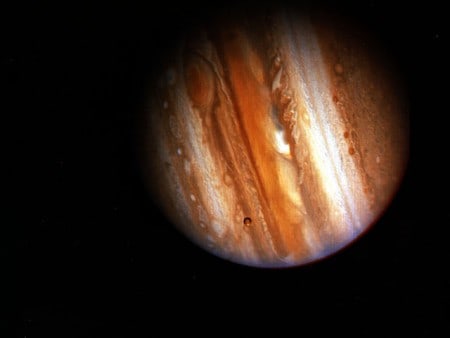Something as trivial as a passing comet could have a huge effect on the future motion of a gas giant like Jupiter, but we cannot know for the time being, claims a physicist in the US. By performing computer simulations, Wayne Hayes from the University of California in Irvine has shown that a more accurate knowledge of the positions of Jupiter, Saturn, Uranus and Neptune is required before scientists can determine whether chaos exists in the planets' trajectories (Nature Physics advance online publication).

Physicists have known for some time that the motions of Pluto and the inner planets are chaotic. This means that a small external force on a planet could, over time, cause a major change in the position of the planet within its orbit. Although no planets are likely to collide or be ejected from the Solar System anytime soon, the chaos means that the orbits of these planets cannot be forecasted with any long-term reliability.
Whether the orbits of the gas giants are chaotic, however, is less certain — some computer simulations have found chaos while others have not. One cause of this confusion could be “numerical artefacts” — spurious errors that accumulate, for example, when a computer rounds-off the results of successive calculations.
But according to Hayes the discrepancy is actually a result of the uncertainty in astronomers’ knowledge of the current conditions of the planets, which are used as input to the simulations. Although from observations we know the orbital positions of the gas giants to an accuracy of a few parts in 10 million, even that tiny amount of uncertainty can make the difference between regularity and chaos in a system, he says.
Hayes came to his conclusion by performing his own simulations of the Solar System, simplifying the Sun and inner planets as a single mass and calculating the trajectories of the gas giants up to a billion years into the future. To avoid the possibility of numerical artefacts either exacerbating or tempering chaos, he did the calculations using three different integration algorithms.
Hayes found that by starting the simulations at different points within the range of observational uncertainties he could end up with a chaotic progression after times from 2 to 230 million years — or even not at all. This means that we will be unable to determine whether the motions of the gas giants are chaotic until better observations are made, although Hayes told physicsworld.com that he doesn’t know when this will be.
Some physicists think that the existence of chaos in the motion of the gas giants could have an effect on our ability to accurately predict certain properties of the inner planets. One of these is the Earth’s tilt, which has a large impact on climate.



